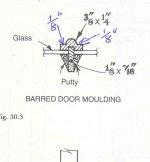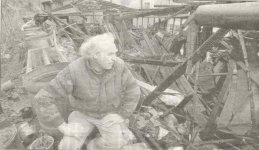Howard et al,
Very quick response before going back down to the shop.
Based on comments in Sheraton, as well as text from Hayward and Hooper, it seems that a very common tool used in making these small "astragals" was a form of scratch-stock. Hooper shows one method, where he works one side of the profile while the piece is attached to a wider board, then sawing it off to work the other side. I'm presuming this would require a special "sticking board." One advantage of this approach is that the groove on the back could also be run while the moulding is attached to the wider board.
Another approach is suggested by Sheraton, though his text deals with glue laminated (veneer) elements for elliptical work. That would be to work with a board the width of the moulded elements and work the full profile on the edge before cutting it off. The text isn't clear, but Sheraton may have been indicating a scratch-stock which will work the full profile at one time. The downside to this is that it is more difficult to run a groove down the back, probably necessitating some kind of special "cradle" for holding the moulding while being ploughed.
Incidentally, for true circular curved elements, Sheraton indicates the sweeps are to be sawn out of solid material, affixed to a backing, and sent off to the turner.
I'd like to think we could make a plane of any profile/size to handle any material, but we're currently so back-ordered that we're not taking any special orders. In lieu of that, given the scale of these elements, I think the scratch-stock really could be fairly efficient. Especially if you planed away some of the waste material, first, with a rabbet or small bench plane.
As to the cross-grain walnut mouldings of the late 17th century, that is something I'd like to do some research on. I would think scratch-stocks might not be the tool of choice for that. The one shown in the drawing from Warne's book is a simple bead (no fillets), so may have been worked with rabbets planes then finished up with a very sharp hollow plane set for a relatively light cut. I believe that would work, but haven't tried that particular operation.
Hope this helps a little.
Don McConnell
Eureka Springs, AR
Very quick response before going back down to the shop.
Based on comments in Sheraton, as well as text from Hayward and Hooper, it seems that a very common tool used in making these small "astragals" was a form of scratch-stock. Hooper shows one method, where he works one side of the profile while the piece is attached to a wider board, then sawing it off to work the other side. I'm presuming this would require a special "sticking board." One advantage of this approach is that the groove on the back could also be run while the moulding is attached to the wider board.
Another approach is suggested by Sheraton, though his text deals with glue laminated (veneer) elements for elliptical work. That would be to work with a board the width of the moulded elements and work the full profile on the edge before cutting it off. The text isn't clear, but Sheraton may have been indicating a scratch-stock which will work the full profile at one time. The downside to this is that it is more difficult to run a groove down the back, probably necessitating some kind of special "cradle" for holding the moulding while being ploughed.
Incidentally, for true circular curved elements, Sheraton indicates the sweeps are to be sawn out of solid material, affixed to a backing, and sent off to the turner.
I'd like to think we could make a plane of any profile/size to handle any material, but we're currently so back-ordered that we're not taking any special orders. In lieu of that, given the scale of these elements, I think the scratch-stock really could be fairly efficient. Especially if you planed away some of the waste material, first, with a rabbet or small bench plane.
As to the cross-grain walnut mouldings of the late 17th century, that is something I'd like to do some research on. I would think scratch-stocks might not be the tool of choice for that. The one shown in the drawing from Warne's book is a simple bead (no fillets), so may have been worked with rabbets planes then finished up with a very sharp hollow plane set for a relatively light cut. I believe that would work, but haven't tried that particular operation.
Hope this helps a little.
Don McConnell
Eureka Springs, AR


